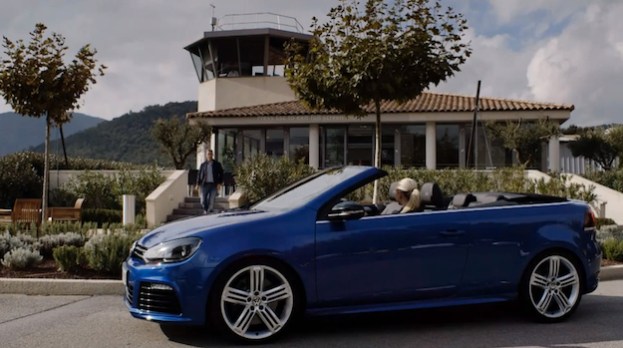
Just a few weeks ago at the LA Auto Show, we were speaking with some of the Volkswagen public relations folks, asking if we’d ever see the Beetle R that the corporate folks in Germany had just announced. They informed us that we would not.
Today comes a glimpse of a vehicle just might be able to get our hands on here in the states: The Golf R Cabriolet. Powered by a turbocharged 2.0-liter inline four-cylinder engine producing 256 horsepower and 243 pound-feet of torque, the Golf R is the most powerful Golf ever sold in the US. With a close-ratio six-speed manual transmission, all-wheel drive, and a 17-PSI BorgWarner turbocharger, the Golf R will achieve 19 MPG city and 27 highway.
We’ve seen stolen patent images and spy shots of the Golf R Cabriolet for a while now, but this is the first look at the vehicle in motion. And boy does it look and sound good.
Part of the cache of owning a hot hatch, like the standard Golf R is its ability to be a mental, road-hugging German machine and just as easily become a sensible utility vehicle. The Golf R Cabriolet gives up half of that equation – at least — when it loses its roof.
The roof will undoubtedly fold in a matter of seconds but will then stow where there once was a cavernous hatch space. Not only that, as previous convertible-ized cars of the past have demonstrated; when you cut the roof off, you sacrifice driving crispness. Suddenly a very well mannered hot hatch is rendered a loose lump of metal as the roof holds a lot of stiffness in the body.
Regardless of its potential loss of utility and responsiveness, we think the Golf R Cabriolet looks fantastic. Not only that, the Cabriolet version of the Golf R would fill a much-needed hole in the market: an accessible, fast, all-wheel drive German convertible.
No specifics have been released on the Golf R Cabriolet at this time but we’ll be certain to keep our ears to the ground and bring you information as soon as it comes available.
Editors' Recommendations
- Volkswagen Golf GTI and Golf R blend power, practicality, and tech
- Volkswagen CEO says ID.3 will be 40% cheaper to make than the e-Golf
- Watch as Volkswagen’s ID R racer wins the ultimate EV bragging rights


